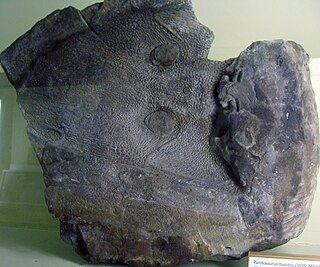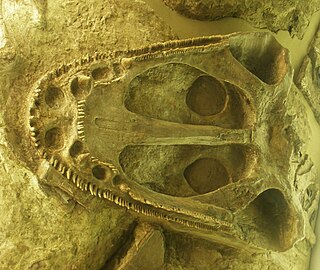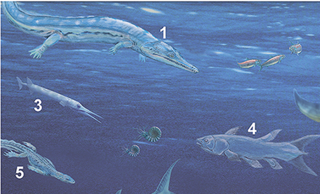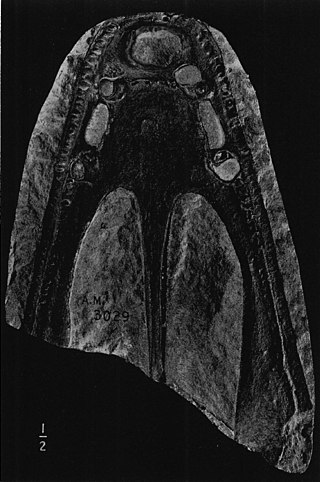
Dissorophoidea is a clade of medium-sized, temnospondyl amphibians that appeared during the Moscovian in Euramerica, and continued through to the Late Permian and the Early Triassic of Gondwana. They are distinguished by various details of the skull, and many species seem to have been well adapted for life on land.

Parotosuchus is an extinct genus of capitosaurian temnospondyls within the family Mastodonsauridae. Fossils are known from the Early Triassic of Europe, Africa, Australia, and Antarctica. It was about 2 metres (6.6 ft) long and likely lived in aquatic environments such as lakes and rivers. Parotosuchus was covered in a scaly skin, unlike the smooth skin of modern-day amphibians, and probably moved with an eel-like motion in the water.

Trematosaurus is an extinct genus of trematosaurid temnospondyl amphibian found in Germany and Russia. It was first named by Hermann Burmeister in 1849 and the type species is Trematosaurus brauni.

Nigerpeton is an extinct genus of crocodile-like temnospondyls from the late Permian (Changhsingian) period. These temnospondyls lived in modern-day Niger, which was once part of central Pangaea, about 250 million years ago. Nigerpeton is a member of the Cochleosauridae family, a group of edopoid temnospondyl amphibians known from the late Carboniferous (Pennsylvanian) and early Permian (Cisuralian).

Mastodonsauridae is a family of capitosauroid temnospondyls. Fossils belonging to this family have been found in North America, Greenland, Europe, Asia, and Australia. The family Capitosauridae is synonymous with Mastodonsauridae.

Trematosauridae is a family of large marine temnospondyls with several included genera.

Wantzosaurus was a genus of temnospondyl amphibian of the Trematosauridae family. Fossils have been found in the Early Triassic Middle Sakamena Formation of what is now Madagascar. It showed adaptations for an almost completely aquatic lifestyle, having the ability to swim by lateral undulation. A pelagic lifestyle for this animal has been proposed.

Trematosaurinae is a subfamily of temnospondyl amphibians within the family Trematosauridae. Like all trematosaurids, they were marine piscivores, resembling crocodiles in their general build. Unlike the long, almost gharial-like snouts of the Lonchorhynchinae, the Trematosaurinae had more "normal" crocodile-like skulls.

Lonchorhynchinae is a subfamily of temnospondyl amphibians within the family Trematosauridae.
Arganasaurus is an extinct genus of temnospondyls belonging to the family Metoposauridae that lived in Morocco during the Late Triassic (Carnian).
Angusaurus is an extinct genus of trematosaurian temnospondyl within the family Trematosauridae.
Almasaurus is an extinct genus of trematosaurian temnospondyl within the family Latiscopidae. It is known from several skulls and some postcranial material found from the Argana Formation in Morocco, which dates back to the Late Triassic.
Indolyrocephalus is an extinct genus of prehistoric amphibian belonging to the family Trematosauridae. It contains a single species, I. huxleyi, from the Early Triassic Panchet Formation of India. It was initially classified in Gonioglyptus, then into its own genus Indolyrocephalus, and then back into Gonioglyptus, but is presently placed in Indolyrocephalus once again.
Cosgriffius is an extinct genus of trematosaurian temnospondyl within the family Trematosauridae. It was described in 1993 by Samuel P. Welles based on a single partial skull from the well-known Meteor Crater Quarry in Arizona that also produced more abundant remains of the capitosaur Wellesaurus peabodyi. The skull was long and slender, features typically associated with the trematosaurid subfamily Lonchorhynchinae. This is the only trematosaurid known from western North America.
Gonioglyptus is an extinct genus of trematosaurian temnospondyl within the family Trematosauridae. It is known from the Early Triassic Panchet Formation of India. It contains two species: G. longirostris and G. fragilis. The species G. kokeni from Pakistan has since been reclassified into Aphaneramma.
Lyrocephaliscus is an extinct genus of trematosaurian temnospondyl within the family Trematosauridae.
Wellesaurus is an extinct genus of mastodonsauroid temnospondyl. They were amphibious carnivores that lived in freshwater environments.

Trematosuchus is an extinct genus of trematosaurian temnospondyl within the family Trematosauridae from South Africa. The type species was first named by Haughton in 1915 as Trematosaurus sobeyi. It was assigned to its own genus, Trematosuchus, by D.M.S. Watson in 1919.

Stanocephalosaurus is an extinct genus of large-sized temnospondyls living through the early to mid Triassic. The etymology of its name most likely came from its long narrow skull when compared to other temnospondyls. Stanocephalosaurus lived an aquatic lifestyle, with some species even living in salt lakes. There are currently three recognized species and another that needs further material to establish its legitimacy. The three known species are Stanocephalosaurus pronus from the Middle Triassic in Tanzania, Stanocephalosaurus amenasensis from the Lower Triassic in Algeria, and Stanocephalosaurus birdi, from the middle Triassic in Arizona. Stanocephalosaurus rajareddyi from the Middle Triassic in central India needs further evidence in order to establish its relationship among other Stanocephalosaurs. Like other temnospondyls, Stanocephalosaurus was an aquatic carnivore. Evidence of multiple species discovered in a wide range of localities proves that Stanocephalosaurus were present all across Pangea throughout the early to mid Triassic.

Bunostegos is an extinct genus of pareiasaur parareptile from the Late Permian of the Agadez Region in Niger. The type species, Bunostegos akokanensis, was named from the Moradi Formation in 2003. It was a cow-sized animal with a distinctive skull that had large bony knobs, similar in form to those of other pareiasaurs but far larger. The species appears to have lived in a desert in the centre of the supercontinent of Pangaea.












